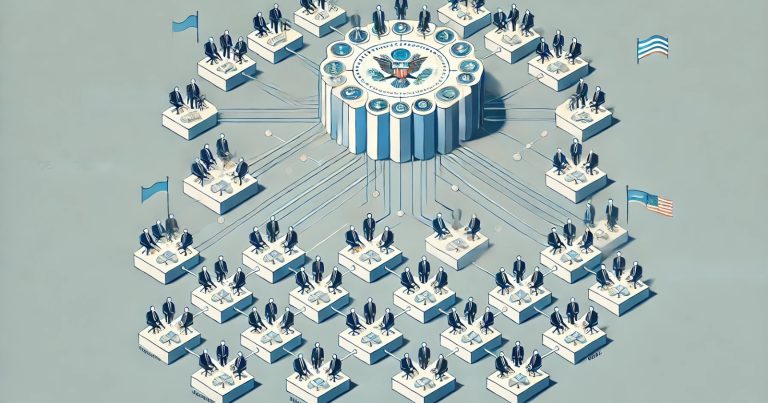The example of decentralisation can be witnessed in many areas, including governance, business management, and financial systems. decentralisation refers to decentralising power and decision-making authority from the central to lower levels, such as local governments, regional offices, or branch managers. In India and other countries, using decentralisation of power helps improve governance. It is also common in large businesses where decisions are made at the regional offices. Understanding centralisation and decentralisation helps learners, practitioners, and decision-makers make more informed administrative choices.
What is Decentralisation?
Decentralisation is the transfer of authority from a central level to lower levels in an organisation, government, or system. This will allow local entities or branches to make their decisions independently but within the main framework set down by the central authority. Democratic decentralisation ensures the participation of local bodies in any form of decision-making for better governance.
Difference Between Centralisation and Decentralisation
Centralisation and decentralisation are two ways through which organisations and governments manage decision-making. Centralisation keeps the power at the top, while decentralisation disperses authority across different levels for better flexibility and efficiency.
| Aspect | Centralisation | Decentralisation |
| Decision-Making | Done at the top level. | Distributed among different levels. |
| Flexibility | Less flexible due to strict control. | More flexible with quick decision-making. |
| Authority | Concentrated in a few hands. | Shared among various levels. |
| Examples | Traditional monarchy, highly controlled businesses. | Local government, multinational corporations. |
Example of Decentralisation
Decentralisation is present in multiple fields, from governance to business operations. Below are some examples of decentralisation that highlight its importance.
Decentralisation in Governance (India’s Panchayati Raj System)
India’s Panchayati Raj System is one of the most notable examples of decentralised governance. The government shifts power at the grassroots level to village-level bodies, which would oversee local development, sanitation and resource distribution. It empowers local leaders by making decisions based on the needs and requirements of the community. Thus, the governance mechanisms become more effective and responsive to the people.
The Gram Panchayat, or the village council, independently decides on road infrastructure, water supply, and educational facilities. Government grants are available to the local bodies to upgrade their infrastructure and service delivery. Leadership at the grassroots level of decision-making guarantees decentralised democracy. Consequently, there would be more responsive local government, problems addressed quickly, and politics would involve greater participation.
Decentralisation in Business (Multinational Corporations – MNCs)
Tata Group, Reliance, Infosys, and many more multinational companies adopt decentralised structures. They let regional managers make decisions instead of relying on corporate headquarters. It benefits a business response to customers’ needs and changes in the market. This decentralisation ensures that business operations run smoothly across different regions.
Regional branches decide their marketing strategies. The store managers decide pricing and sales tactics based on the demand in their respective areas. Corporate headquarters can provide guidelines but cannot control everything. This system accelerates decision-making, increases adaptability, and boosts customer satisfaction. Companies using decentralisation can effectively serve different markets.
Decentralised Planning in India
The Indian government promotes decentralised planning through state and district-level bodies. It is a system where each state can decide on its development priorities according to local needs. This ensures better usage of resources because the control over education, health, and infrastructure budgets is given to the decentralised planning system. It enables local governments to make decisions suitable for their people.
District collectors undertake regional projects. Villages also participate in the planning through Gram Sabhas. States look after their policies, minimising the need to depend on the central government. This process also enhances the use of resources and results in more region-specific policies. Development occurs faster and more effectively with decentralised planning.
Decentralisation in Financial Systems (Cryptocurrency & Blockchain)
Blockchain and Bitcoin are examples of decentralised finance. In the system, no one controls transactions, unlike in traditional banking. People can directly transfer money between each other with no middleman, such as a bank, involved. Individuals have more control and security with their finances through this system.
Blockchain ensures that financial records are transparent and safe. It decreases the cost of banking through a direct user-to-user transaction that increases financial inclusion. Since it is decentralised, eliminating the central authority, it reduces fraud risk. Giving control over their money to individuals through decentralising finance makes the financial system fairer and more accessible.
Importance of Decentralisation
Decentralisation plays a paramount role in governance, business, and finance. Decentralisation enhances efficiency, accountability, and economic development.
- Quicker Decisions: Local governments can make quicker decisions without awaiting central approval. Problems are, therefore solved in real time, thus enhancing efficiency in daily operations.
- Better governance: Democratic decentralisation enhances participatory and responsiveness at the grassroots level. Therefore, decisions can be more community needs and preference-oriented, meaning that people could have more confidence in local authorities.
- Improved Service Delivery: Health care, education, and infrastructure projects become more efficient. Local authorities can focus on the most important services to their people and respond promptly and precisely.
- Economic Development: When local managers have authority, businesses expand faster. Businesses can take advantage of local opportunities and respond strongly to changing market conditions if they have the power to make decisions in their area.
- Flexibility and Innovation: Decentralised businesses respond promptly to market conditions. Regional managers are encouraged to innovate and find solutions for the regional demand.
Advantages of Decentralisation
The benefits of decentralisation are both for governments and businesses. Decentralisation provides a responsive and dynamic environment.
- Increases efficiency: The decision-making process is faster at local levels. This enables the local authorities to respond faster to community needs and challenges.
- Encourages participation at a local level: Citizens and employees feel empowered. This results in increased motivation and ownership in the success of the community or business.
- Reduces the workload of central authorities: The central government or head office can concentrate on strategic planning. It can address the more general, long-term issues better by delegating tasks.
- Promotes Economic Growth: With the proliferation of small businesses and regional industries, strong economic growth is encouraged due to local decisions. Businesses become more responsive to specific market requirements and grow more rapidly.
- Improves accountability: The leaders and managers take responsibility for their choices. Such responsibility calls for performance improvement and creates confidence within communities and organisations.
Disadvantages of Decentralisation
Although it has its merits, decentralisation has its shortcomings. Governments and businesses must, therefore, overcome these issues for effective decentralisation.
- Unequal resource distribution: Some regions may lack the funding or infrastructure. The imbalance causes slower development in lesser-developed areas.
- Coordination Issues: Authorities at different levels may face a communication gap. Such a gap may delay or make inefficient decision-making processes at various governance levels.
- Risk of Corruption: Local leaders may misuse their power. The absence of proper oversight might undermine the benefits of decentralisation as corruption undermines services and resources.
- Lack of Skilled Personnel: Some decentralised bodies do not have sufficient training. This deficit can lower the quality of services, especially in healthcare and education.
- High Administrative Cost: Administering several decentralised units is costly. High overheads for administering various branches or regions can drain resources from other tasks.
Example of Decentralisation FAQs
What is decentralisation?
Decentralisation means transferring decision-making power from a higher central level to lower levels in governance, business, or finance.
What are the example of decentralisation in India?
An excellent example of decentralisation can be seen in the Panchayati Raj System in India, where local bodies of village management handle matters of governance and development.
Distinguish between centralisation and decentralisation?
Centralisation and decentralisation are distinct concepts because, under centralisation, decision-making remains at the top level, whereas under decentralisation, power disperses across a range of levels.
What are the benefits of decentralisation?
The benefits of decentralisation include accelerated decision-making processes, good governance, economic growth, and better accountability.
What is decentralised planning?
decentralised planning refers to a scheme wherein local governing units and provinces design their respective plans for development without depending upon central authorities.


